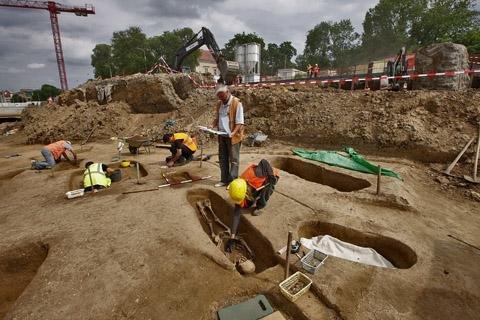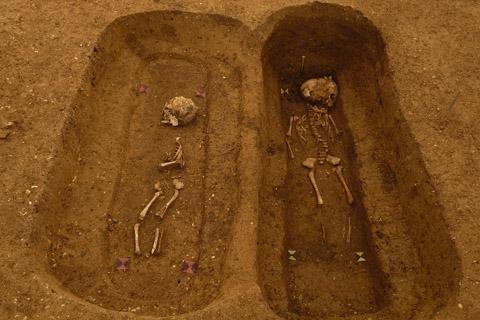Blanka Tunnel threatens relics
Dig unearths problems with city funding for archaeology
Filip Šenk
Source - http://www.praguepost.com/news/13777-blanka-tunnel-threatens-relics.html

Courtesy Photo- Construction of the 6.4-kilometer-long tunnel, aimed at reducing traffic near the castle, has been held up after collapses and, in 2011, the discovery of a mass grave.
Archaeologists conducting research on the Blanka Tunnel construction site have made several important excavations, revealing new knowledge on Prague's ancient history but also on the potential mismanagement of city funds.
The scientists say they are having troubles receiving funds for their work from City Hall. Although Prague officials deny the allegations, the row presents a potentially explosive legal conundrum for one of the city's most expensive undertakings.
Researchers have been working on the Blanka site since 2008, when construction first began. They say the city owes them some 1.1 million Kč in unpaid claims.

Courtesy Photo - The burial site dates to the Middle Ages and contained children.
"Certain troubles with payment were always present," said archaeologist Jan Frolík, who is responsible for the financial issues of the research. "At the moment, we are bothered by an unpaid financial claim for the period of September 2011 to January 2012."
According to the latest information confirmed by Luboš Jiráň, director of the Institute of Archaeology, the researchers reached an agreement with City Hall July 16, and the city representatives pledged to pay the debt within two or three weeks.
The city is required by law to secure and fund the archaeological research on the site. If the research is not compensated, the scientists must decide whether to protect the findings and cause debts to their institution, the Czech Academy of Sciences, or allow damage to archaeological discoveries.
"Every archaeologist is taught to protect relics," Frolík said. "It is a part of very basic professional ethics."
This decision to continue digging in order to preserve the finds has left the AV's Institute of Archaeology saddled with debt, Frolík explained. Aside from the wages of scientists and researchers, the institute covers the costs of diggers, technicians, geodesists and other necessary technical support.
Frolík also confirmed that research on the site had been on hold since July 9. Although the scientists said they would resume work after their July 17 agreement with city officials, their eight-day hiatus placed Metrostav, the main construction firm overseeing the Blanka project, in murky legal waters.
"The research is not secured by a contract, and we do not intend to continue until the matter is solved," Frolík said. "If the construction company keeps working, it is committing a criminal act because it damages or destroys archaeological findings."
According to City Hall spokeswoman Tereza Králová, the city was fulfilling all of its obligations to the archaeological institute.
"The city, through its city investor department, has paid the institute everything on time so far, sufficiently in order," she said. "The current demands are being examined by the department to determine whether they are legitimate."
Králová also said the tunnel's construction was not under threat, nor did she expect a delay in work progress.
Tunneling funds
Blanka Tunnel, aimed at easing traffic congestions in the city center, has faced a multitude of issues since construction began four years ago. The 6.4-kilometer project has seen building costs rise from the originally projected 27 billion Kč to an estimated 37.1 billion Kč, as well as suffering several land collapses.
According to Martin Skalský, a member of the watchdog civic association Auto*mat, problems with finances have emerged in the past: For example, certain invoices were paid twice. However, he stressed it is difficult to draw conclusive evidence because Blanka's bookkeeping is not public.
"The problems have been there from the very beginning because the whole project lacks efficient control mechanisms," Skalský said. He also said that with Mayor Bohuslav Svoboda and his team now in charge of City Hall, the attitude of politicians has changed for the better, although it was impossible to eliminate questionable practices completely due to existing valid contracts and other objective obstacles.
Meanwhile, the arduous construction process has revealed new details of Prague's anthropological and geological history. Located near Prague Castle, the tunnel is being dug in sites representing the city's early history. A majority of research and construction is taking place north and west of Prague Castle and Hradčany, from Letná to Střešovice.
The most significant discovery happened in 2011, when the team of archaeologists found an early Middle Ages burial ground beneath the intersection of Milady Horákové and Svatovítská street in Prague 6.
"Seventy-seven graves were discovered, including 29 children's graves, including infants," said leading archaeologist Kateřina Tomková. "Based on the earrings, beads and ceramics found in the graves of children and women, we can preliminary date the burial site to the end of 9th century and first half of 10th century - in other words, to the times of the founding of the Czech state."
The construction site's proximity to Prague Castle also gives archaeologists an opportunity to find out more about ancient routes leading north. These routes were for many centuries crucial for trade and commerce, making them an ideal location for future discoveries.
The city has formed over many centuries, and each period left its mark. One of the most visible monuments of the Baroque era in Prague is the large defense structures, or bastions. The Blanka excavations have also shed new light on these. For example, the research team found remains of an unknown wall that used to be part of the city fortification system near bastion XI, located on the western side of the dig.
"We've compiled a large collection of findings and information that will be worked on after research is over with other experts from the Institute of Archaeology, as well as other institutions," Tomková said.
For now, archaeologists plan to work close to the area where they found the early Middle Ages burial ground in search of additional graves. They also plan to explore the area near the Baroque bastions to see how the city fortification system developed.